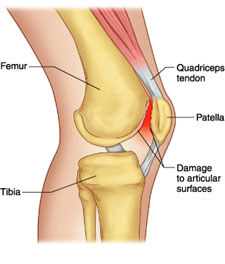Anterior knee pain - Sports Medicine Doctor Malta - Dr Danica Bonello Spiteri
Main menu:
Anterior knee pain
Anterior Knee Pain (First published on vida magazine on April 2013)
Anterior knee pain is often referred to as patellofemoral syndrome or chondromalacia patellae (literally meaning soft cartilage under the knee cap). This common condition refers to pain often located at the front, or just behind the knee cap. The pain usually comes on when going down stairs, walking downhill or when sitting for prolonged periods of time, such as when you go to see a film at a cinema. It has been also called movie goer’s knee, and causes the person needing to stretch their legs to ease off the pain.
Chondromalacia patellae occurs when the tissue, known as cartilage, on the back of the knee cap (patella) is getting worn out and broken down since it is rubbing against the thigh bone (femur) that lies underneath the knee cap. The rubbing of the cartilage results in an irritated cartilage, and this is the main cause of the pain reported.
If this is not corrected, it often gives rise to persistent and painful osteoarthritis of the knee cap in the long term.
So what causes this cartilage breakdown to occur?
It is quite simple actually. The knee cap usually sits on the front of your knee joint, and as you bend and straighten your knee, the patella glides up and down. The movement of the patella is controlled by your thigh muscles (quadriceps) and the patellar tendon, which attaches the knee cap to the shin bone.
Pain begins when the knee cap does not move properly in its correct position and starts to rub on different parts of the thigh bone underneath causing cartilage irritation.
This can happen due to a variety of reasons:
The knee cap is in an abnormal position
Tight or weak muscles around the thighs
Flat feet
Doing too much activities that stress the kneecap
Increased weight
To correct the problem, analysis of the cause is essential, in order to tailor treatment towards the cause of the problem. Possible solutions may include:
Adapting the way exercise is done
Specific exercises directed towards stretching and strengthening muscles around the knee joint
Losing weight (if overweight)
Insoles in shoes to correct flat feet
Taping the knee cap to re-
align it in its correct position Wearing the correct sports shoes
Surgery is rarely required for this type of problem as the pain will be expected to improve with a change in exercise patterns and with the adequate exercise regime for rehabilitation. It is also documented that few people actually benefit from surgery, hence this has lost popularity.


For direct contact or to book a consultation please send an email on:
drdanica@sportsmedicinemalta.com